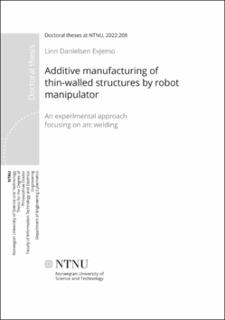| dc.contributor.advisor | Gravdahl, Jan Tommy | |
| dc.contributor.advisor | Moe, Signe | |
| dc.contributor.advisor | Aune, Ragnhild | |
| dc.contributor.advisor | Brøtan, Vegard | |
| dc.contributor.author | Evjemo, Linn Danielsen | |
| dc.date.accessioned | 2022-06-16T07:18:13Z | |
| dc.date.available | 2022-06-16T07:18:13Z | |
| dc.date.issued | 2022 | |
| dc.identifier.isbn | 978-82-326-6624-9 | |
| dc.identifier.issn | 2703-8084 | |
| dc.identifier.uri | https://hdl.handle.net/11250/2998990 | |
| dc.description.abstract | Additive manufacturing (AM) has, over recent decades, become a quickly evolving and ever more present part of production and manufacturing. It has gone from being a simple prototyping method to building more complex prototypes more quickly and more accurately, and even for manufacturing smaller end products, which is financially advantageous for products in small quantities. Most off-the-shelf AM methods are, however, limited by both the geometry and the size of builds, as they mostly require the component to be built layer-by-layer within a chamber. Robotised AM is on its way to help solve these challenges, making AM technology more useful and available for industry in the future.
This thesis presents contributions in robotised additive manufacturing, focusing on manufacturing metal structures using methods that deviate from the most common methods for AM. The papers present proof-of-concept results of non–layer-wise material deposition as a step towards expanding the range of geometries possible in AM. From there, different challenges related to the construction of thin-walled metal structures using wire-arc additive manufacturing (WAAM) are examined. A set-based control method is examined as a possible solution for enabling non-vertical material deposition in WAAM, and, lastly, more complex structures with overhangs are built by depositing material orthogonally onto surfaces already built.
The accompanying text presents the motivation behind this research, and an introduction to the set-based control method used in some of the experiments. The principles behind the focus on WAAM technology is explained by introducing the main arc welding methods, and examining which method is most easily combined with robotic deposition of material. An overview of the most common methods for AM is also given, in order to fully understand why non-vertical material deposition is a topic worth researching. | en_US |
| dc.language.iso | eng | en_US |
| dc.publisher | NTNU | en_US |
| dc.relation.ispartofseries | Doctoral theses at NTNU;2022:208 | |
| dc.relation.haspart | Paper 1: Evjemo, Linn Danielsen; Moe, Signe; Gravdahl, Jan Tommy; Roulet-Dubonnet, Olivier; Gellein, Lars Tore; Brøtan, Vegard.
Additive manufacturing by robot manipulator: An overview of the state-of-the-art and proof-of-concept results. I: 22nd IEEE International Conference on Emerging Technologies And Factory Automation. IEEE conference proceedings 2017
https://doi.org/10.1109/ETFA.2017.8247617 | en_US |
| dc.relation.haspart | Paper 2: Evjemo, Linn Danielsen; Langelandsvik, Geir; Gravdahl, Jan Tommy. Wire arc additive manufacturing by robot manipulator: Towards creating complex geometries. IFAC-PapersOnLine 2019 ;Volum 52.(11) s. 103-109 https://doi.org/10.1016/j.ifacol.2019.09.125 | en_US |
| dc.relation.haspart | Paper 3: Evjemo, Linn Danielsen; Moe, Signe; Gravdahl, Jan Tommy. Robotised Wire Arc Additive Manufacturing Using Set-based Control: Experimental Results. IFAC-PapersOnLine 2021 ;Volum 53.(2) s. 10044-10051 https://doi.org/10.1016/j.ifacol.2020.12.2725
This is an open access article under the CC BY-NC-ND license | en_US |
| dc.relation.haspart | Paper 4: L. D. Evjemo, G. Langelandsvik, S. Moe, M. H. Danielsen, and J. T. Gravdahl. Wire-arc additive manufacturing of structures with overhang: Experimental results depositing material onto fixed substrate. CIRP Journal of Manufacturing Science and Technology, 38, 186-203 (2022) https://doi.org/10.1016/j.cirpj.2022.04.006 Attribution 4.0 International (CC BY 4.0) | en_US |
| dc.title | Additive manufacturing of thin-walled structures by robot manipulator : An experimental approach focusing on arc welding | en_US |
| dc.type | Doctoral thesis | en_US |
| dc.description.localcode | “In reference to IEEE copyrighted material which is used with permission in this thesis, the IEEE does not endorse any of [name of university or educational entity]’s products or services. Internal or personal use of this material is permitted. If interested in reprinting/republishing IEEE copyrighted material for advertising or promotional purposes or for creating new collective works for resale or redistribution, please go to http://www.ieee.org/publications_standards/publications/rights/rights_link.html to learn how to obtain a License from RightsLink. | en_US |
